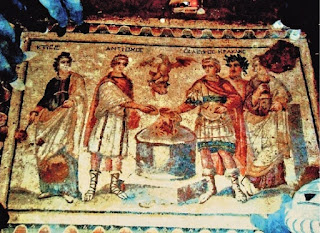During clandestine excavations on the site of Apamea in October 2011, a mosaic with a very rare and unusual scene was discovered as it represented the foundation of Antioch on the Orontes by Seleucos in 300 BC. The work is obviously Roman and has been dated to the 4th century AD. What makes the picture so unique is that it shows the religious sacrifice as performed by Seleucos I and his son Antiochus I.
The name Apamea appeared in 300 BC when Seleucos, a successor of Alexander, created one of the grandest cities in the east. At the Susa mass wedding of 324 BC, Seleucos married Apame, the daughter of Spitamenes of Bactria. Apame accompanied her husband during all of his expeditions and campaigns. After conquering the east, Seleucos established another capital of his empire at Antioch on the Orontes, today's Antakya in Turkey Mediterranean to the Indus. Seleucos truly moved in Alexander's footsteps, and like him, he built many cities, which are said to be all named after family members. One city was named after his father, Antioch; five after his mother, Laodicea; four after his two wives, Apamea and Stratonikea; and last but not least, nine were baptized Seleucia after himself.
After being incorporated into the Roman Empire , Apamea grew to harbor 250,000 people and became very rich. It was a military base and was renowned for breeding military horses. This explains the monumental remains of private and official buildings we still see today on both sides of the colonnaded Cardo.
The above-mentioned mosaic was created when the city reached its peak of refinement between the 3rd and the 5th century AD. The alarming fact is that the mosaic has disappeared, probably sold on the black market to some art collector. It is quite peculiar that we have a photograph of this beautiful composition made by an unknown author, even if it is not the best shot. The mosaic may have been decorating the floor of a house belonging to some high official, as it covers about 10 m2 .
[Picture downloaded from Pinterest]
A Greek inscription identifies the sacrifice attended by five standing figures above which floats an eagle, representing Zeus, holding a bull’s head in its claws. We see Seleucos I Nicator (the Victorious) and Antiochus I Soter (the Savior) standing on either side of an altar with a fire burning on which a bull is being sacrificed. Seleucos wears a blue tunic underneath his parade cuirass and a purple cloak; his head is crowned with a golden tiara. Antiochus, in turn, is dressed in a white tunic trimmed with two black stripes covered with a purple cloak as well; he wears some jewels. Next to Seleucos, we recognize Heracles and the Muse Calliope, and next to Antiochus, we find Ktisis, the female personification of the city, holding the tools of the architect. The two women are clad in a belted chiton and show their jewelry.
Interpol has now launched an official search for this out-of-common mosaic. Unfortunately, this is not the only one that has disappeared from the Apamea site that was badly damaged when the IS occupied the region. Please keep on the lookout!
[For more mosaic news, read also: More illegal mosaics from Apamea]
[For more mosaic news, read also: More illegal mosaics from Apamea]


This historical mosaic from Apamea of Syria had been identified and published first time by Marek Titien Olszewski and Houmam Saad, Interpol à la recherche d’une mosaïque volée à Apamée en Syrie : « La fondation d’Antioche », Archeologia 551, 2017 (Fevrier), pp. 4-5. see:https://www.academia.edu/31593517
ReplyDeleteYes, this information is indeed four months old - a mere breath in eternity!
ReplyDeleteIn journalistic ethic and this also concerns bloggers when quoting unpublished information published for the first time somewhere it is required to cite the source of where the information or description comes from. The blogger gains in all the case on the reliability of the information and its information is considered serious. If not we have doubts ...
ReplyDeleteThank you for pointing this out to me. I'll handle my sources more carefully in the future.
ReplyDelete